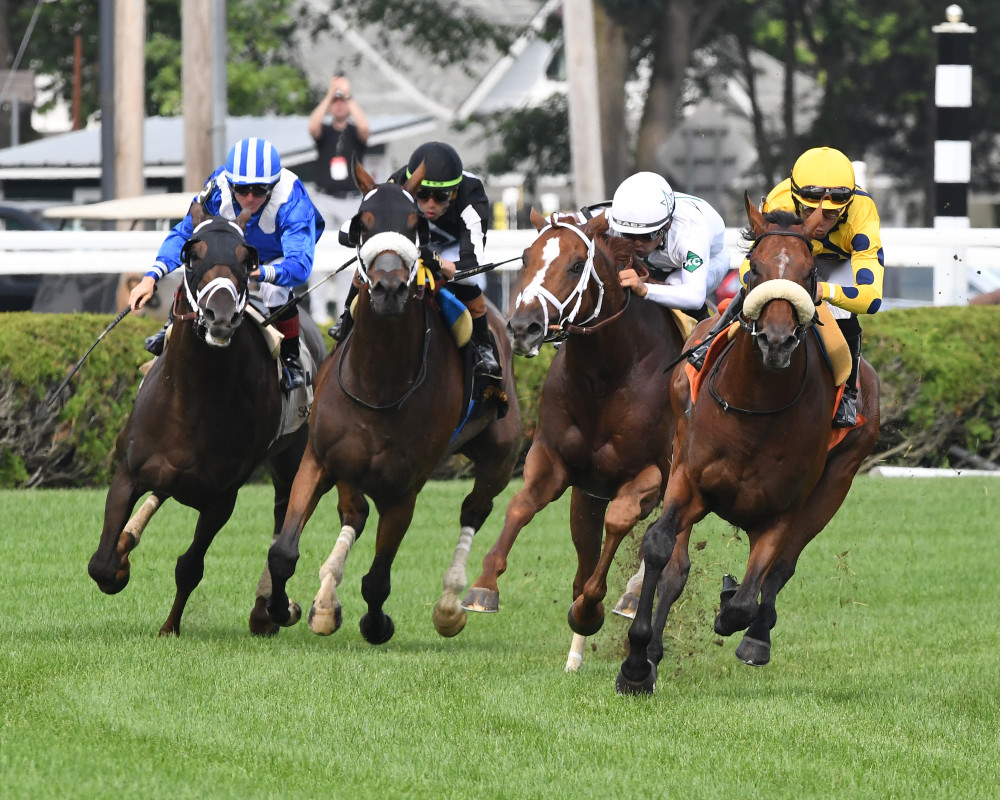Bloodlines Presented By Walmac Farm: What Makes A Turf Horse? originally appeared on Paulick Report.
Some horses excel at racing on turf, rather than dirt, and in explanation of this, there are stride function and mechanical traits that tend to aid horses in showing better form on one surface, rather than another.
So, it’s no great surprise that some sires and dams tend to produce racers that have inherited traits which enable them to race more effectively on turf, and a few stallions in particular come to be labeled “turf sires,” although some of them get good horses on any surface.
Two of the best turf sires in America were the late English Channel (by Smart Strike) and Kitten’s Joy (El Prado), who are the sire and broodmare sire of Far Bridge, the winner of the Grade 2 Bowling Green Stakes at Saratoga on Saturday, July 12.
The 5-year-old Kentucky-bred is out of the Kitten’s Joy mare Fitpitcher and was bred by Calumet Farm. A winner in half of his 18 starts, Far Bridge raced the 11 furlongs in 2:15.38 and won by three lengths from El Rezeen, who is also by English Channel out of a Kitten’s Joy mare.
Advertisement
As two eminent American sires for the traditional classic distances, English Channel and his turf compatriot Kitten’s Joy are a natural match for matings, and they are built to be compatible.
For a horse to race efficiently over turf, it must have excellent extension and power, but they require the power and extension in the reverse order to the usual pattern of racing in America, where most dirt racing demands near-instant acceleration to top speed with a high driving power out of the gate. Dirt racing also starts very fast, most of the time, then decelerates quarter by quarter to the finish, even at the highest levels.
In contrast, turf races can be slow rides on the lead, followed by a sprint to the finish. It is an exciting style of racing that sometimes produces thrilling finishes and is highly visually appealing for audiences watching at the track or on remote devices like television or computer.
Turf horses tend to have a distinctive style of hindleg conformation that will not allow them to race headlong into top speed over a furlong. Instead, they need to build speed as they stride along. That requires strength, cardio volume, good stride cadence, and bags of power to finish when they do reach higher speed and need to call on it.
Those racers that have all the pieces of the “turf horse” can have long and very successful careers because they aren’t putting nearly so much pressure on their legs early and are racing on a more forgiving surface, as well.
Far Bridge, for instance, has earned more than $2.3 million to date and has won three times at the G1 level. He and his kinsman El Rezeen are examples of the talented racers that made English Channel an immensely successful sire, and his stock are often specially trained for racing on turf at distances of at least a mile.
In like kind, the established stallion Karakontie (Bernstein) is especially effective as a sire of turf performers. His most recent stakes winner is Roja, who won the listed Blue Sparkler Stakes at Monmouth Park on July 12.
Roja’s pedigree is at least as turf-friendly as the pedigree of Far Bridge. Not only is the 3-year-old filly by Breeders’ Cup Mile winner Karakontie, but she is also out of a stakes-placed daughter of Red Ransom (Damascus), who sired some of his best performers on turf, and out of a second dam by the turf giant Dynaformer (Roberto).
Related: Never miss a story – Sign up for our newsletters
A winner of the Grand Criterium in France at two, the Poule d’Essai des Poulains (French 2,000 Guineas) and Breeders’ Cup Mile at three, Karakontie is a highly successful sire, most notable for his turf successes, and his daughter She Feels Pretty had won four consecutive turf stakes, three of them at the G1 level, before finishing a close second to Excellent Truth (Cotai Glory) in the G1 Diana Stakes at Saratoga on Saturday.
Unlike She Feels Pretty, Far Bridge, and others, some of the horses who are bred for turf do not excel there. In addition to the ones that fail to excel at anything, there is also the simple fact that inheritance is more random than any breeder of livestock would like it to be.
Some horses with turf performers close up nevertheless inherit physical traits that make them more suited to dirt. Even more commonly, however, is the situation that the offspring inherit some of the traits most suitable for turf racing, as well as other traits that are best suited for dirt racing. This association of different aptitudes makes for an animal with mixed mechanics that tend not to excel at anything.
This is one of the common aspects of breeding that results in breeding toward the norm, the average or median, of the breed. Winning a race with one of those is a trying exercise.
This story was originally reported by Paulick Report on Jul 16, 2025, where it first appeared.
